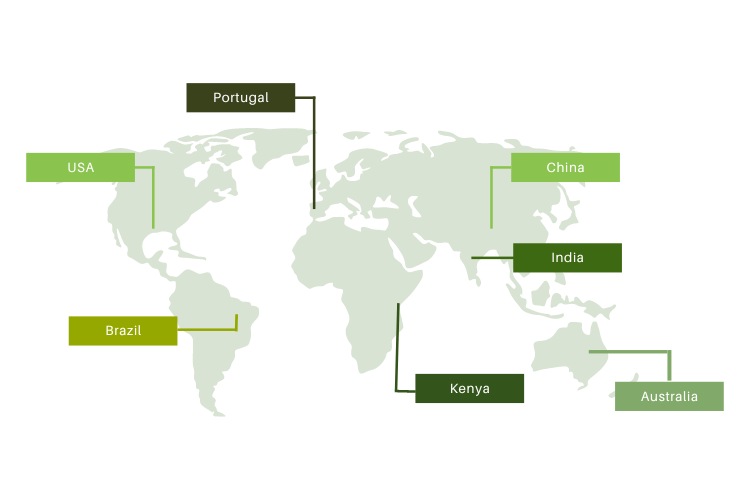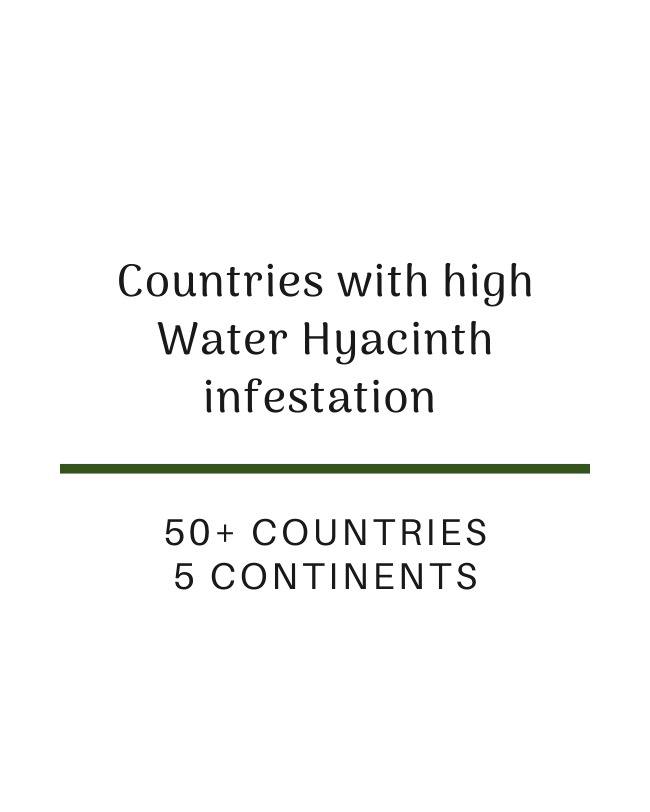Water Hyacinth, scientifically known as Eichhornia crassipes, is recognized as one of the most problematic weeds worldwide. Originally found in Amazonia, Brazil, and potentially Argentina, it has rapidly spread to various regions such as Venezuela, central South America, and the larger Caribbean islands. Despite its initial use as an ornamental plant in garden ponds, the aquatic nature of Eichhornia crassipes and its explosive growth rate have led to significant issues, including the choking of waterways and interference with water supply equipment.

Water Hyacinth-Distributed Globally


A plant that withstand extreme conditions
As a free-floating macrophyte, Eichhornia crassipes reproduces both vegetatively, through the formation of axillary buds on stolons, and sexually via seed production. It thrives in stagnant or slow-moving water, forming dense mats in estuarine habitats, lakes, urban areas, watercourses, and wetlands. This invasive species exhibits remarkable tolerance to various environmental factors, including water level fluctuations, nutrient availability, pH levels, temperature extremes, and certain toxic substances. However, it cannot survive in brackish or saline water conditions. Notably, the growth of Eichhornia crassipes is strongly correlated with nutrient concentrations, particularly nitrogen (N) and phosphorus (P). Today, Eichhornia crassipes has spread to every continent except Antarctica, invading tropical and sub-tropical countries as well as parts of the Mediterranean basin. Its aggressive nature and detrimental impacts on agriculture, the environment, and human activities have prompted global efforts to manage and control its growth. In response, legislative measures to prevent the sale or distribution of this weed are being developed in several countries, including the USA, Australia, New Zealand, South Africa, the United Kingdom, Morocco, and Portugal. Furthermore, the completion and approval of the EPPO PRA on Eichhornia crassipes in 2008 led to the recommendation for its regulation within European and Mediterranean countries.
Today, Eichhornia crassipes has spread to every continent except Antarctica, invading tropical and sub-tropical countries as well as parts of the Mediterranean basin.
List of countries/regions with water hyacinth problem
AMERICAN SAMOA
AUSTRALIA
BAHAMAS
BANGLADESH
BENIN
BERMUDA
BRAZIL
BRUNEI
DARUSSALAM
BURKINA FASO
BURUNDI
CAMBODIA
CAMEROON
CAYMAN ISLANDS
CHILE
CHINA
CHRISTMAS ISLAND
COLOMBIA
CONGO
CONGO
THE DEMOCRATIC REPUBLIC OF THE COOK ISLANDS
COSTA RICA
COTE D’IVOIRE
CUBA
DOMINICAN REPUBLIC
ECUADOR
EGYPT
EQUATORIAL GUINEA
ETHIOPIA
FIJI
FRENCH POLYNESIA
GABON
GHANA
GUADELOUPE
GUAM
GUATEMALA
GUINEA
GUINEA-BISSAU
HAITI
HONDURAS
HONG KONG
INDIA
INDONESIA
ISRAEL
JAMAICA
JAPAN
JORDAN
KENYA
LAKE VICTORIA
LAO PEOPLE’S DEMOCRATIC REPUBLIC
LEBANON
LIBERIA
MADAGASCAR
MALAWI
MALAYSIA
MALDIVES
MARSHALL ISLANDS
MARTINIQUE
MAURITIUS
MEXICO
MICRONESIA
FEDERATED STATES OF MOZAMBIQUE
MYANMAR
NAURU
NEW CALEDONIA
NEW ZEALAND
NICARAGUA
NIGERIA
NORFOLK ISLAND
NORTHERN MARIANA ISLANDS
PALAU
PANAMA
PAPUA NEW GUINEA
PERU
PHILIPPINES
PORTUGAL
PUERTO RICO
REUNION
RIVER NILE
RUSSIAN FEDERATION
RWANDA
SAINT LUCIA
SAMOA
SENEGAL
SIERRA LEONE
SINGAPORE
SOLOMON ISLANDS
SOUTH AFRICA
SPAIN
SRI LANKA
STATE OF PALESTINE
SUDAN
SWAZILAND
SYRIAN ARAB REPUBLIC
TAIWAN TANZANIA, UNITED REPUBLIC OF
THAILAND
TOGO
UGANDA
UNITED STATES
UNITED STATES MINOR OUTLYING ISLANDS
VANUATU
VENEZUELA
VIET NAM
BRITISH VIRGIN ISLANDS
ZAMBIA
ZIMBABWE
Distributed design
Water Hyacinth is a global problem and hence the availability of the raw material is also global, making it easy to scale it to other countries. As 60% of the world is affected by water hyacinth, biomaterials from it can be produced locally – distributed globally, by collaborating with fablabs and makerspaces using their inventory.
The production of biomaterials from water hyacinth present an effective model of decentralized production. As water hyacinth can be found all over the world, it serves as an abundant resource for manufacturing. This approach embraces the concept of producing locally and distributing globally, challenging the traditional mass production model of the 20th century. By eliminating the need for time-consuming shipping, showrooms, and storage, this model offers a fast, affordable, and sustainable alternative. It bypasses the necessity for large factories or warehouses and minimizes the shipping of materials across the globe. Instead, customers are connected to independent makers through the global Pola network. This network leverages the global fablab/makerspace infrastructure, while also forging partnerships with local organizations like NGOs. These partnerships enable the involvement of the local workforce in the harvesting, cleaning, and drying of water hyacinth, preparing it for production. This distributed, on-demand manufacturing approach allows for the rapid, affordable, and localized establishment of workplaces worldwide. Through this innovative framework, biomaterial production from water hyacinth becomes a catalyst for economic empowerment and sustainability within local communities.
Spain/Thailand
The biomaterials were created in Spain at the Institute for Advanced Architecture of Catalunya. Although Water Hyacinth is a problem in the Guadiana River that flows through Spain and Portugal, the collection is not possible during Winter and hence the water hyacinth from Thailand were used for the project. Further research of the project will be done in the Waag Future Lab, Netherlands from September, 2023. A community network for Spain and Portugal needs to be created.
India
The first community development is being carried out in Kochi, Kerala with the help of the local governing body. Another regional network is being planned in Kolkata with the support of Kadam, an organisation that work with craft clusters across the country. The possibility of INHAF as a regulatory organisation for the regions is being explored. Superfablab, kochi and Vigyan Ashram as the production facilities are being investigated.
Bhutan
A regional material exploration is planned at Bhutan in connection with the FAB 23 conference. Alternative local materials for each additive is to be figured out. A country heavily depended on import of raw materials, this could be critical. A community development may not be possible at this point in Bhutan. However this would help in creating a regional network at a later date.
Create a lasting visual impact with sustainable products and better use of technology.
Where to find us
Prayaana Infomedia, Infopark TBI, 1ST Floor, Jawaharlal Nehru Stadium, Kaloor, Ernakulam, Kerala
Phone: 9809080888
soulsanchi@gmail.com